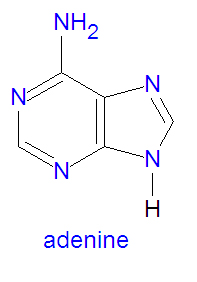Adenine: Difference between revisions
Jump to navigation
Jump to search

Pat Palmer (talk | contribs) (adding HMDB ref) |
Pat Palmer (talk | contribs) mNo edit summary |
||
| Line 20: | Line 20: | ||
Adenine is also present in [[adenosine monophosphate]] (AMP), [[adenosine diphosphate]] (ADP), [[adenosine triphosphate]] (ATP), [[NADH]] and [[NADPH]], chemicals involved in the energy cycle and oxidation reduction steps within biology [[cell]]s. | Adenine is also present in [[adenosine monophosphate]] (AMP), [[adenosine diphosphate]] (ADP), [[adenosine triphosphate]] (ATP), [[NADH]] and [[NADPH]], chemicals involved in the energy cycle and oxidation reduction steps within biology [[cell]]s. | ||
== | == Notes == | ||
<references> | |||
</references> | |||
[[Category:Reviewed Passed]][[Category:Suggestion Bot Tag]] | [[Category:Reviewed Passed]][[Category:Suggestion Bot Tag]] | ||
Latest revision as of 07:55, 13 July 2024
|
| |||||||
| adenine | |||||||
| |||||||
| Uses: | DNA RNA | ||||||
| Properties: | natural base | ||||||
| Hazards: | |||||||
| |||||||
Adenine[1] is a naturally occurring base found in the nucleic acids DNA and RNA. When adenine is attached to a ribose or deoxyribose sugar, the complex is called adenosine. It is in this from that adenine is found in nucleic acids.
Adenine is also present in adenosine monophosphate (AMP), adenosine diphosphate (ADP), adenosine triphosphate (ATP), NADH and NADPH, chemicals involved in the energy cycle and oxidation reduction steps within biology cells.
Notes
- ↑ Adenine (HMDB0000034) in the Human Metabolome Database (HMDB).
